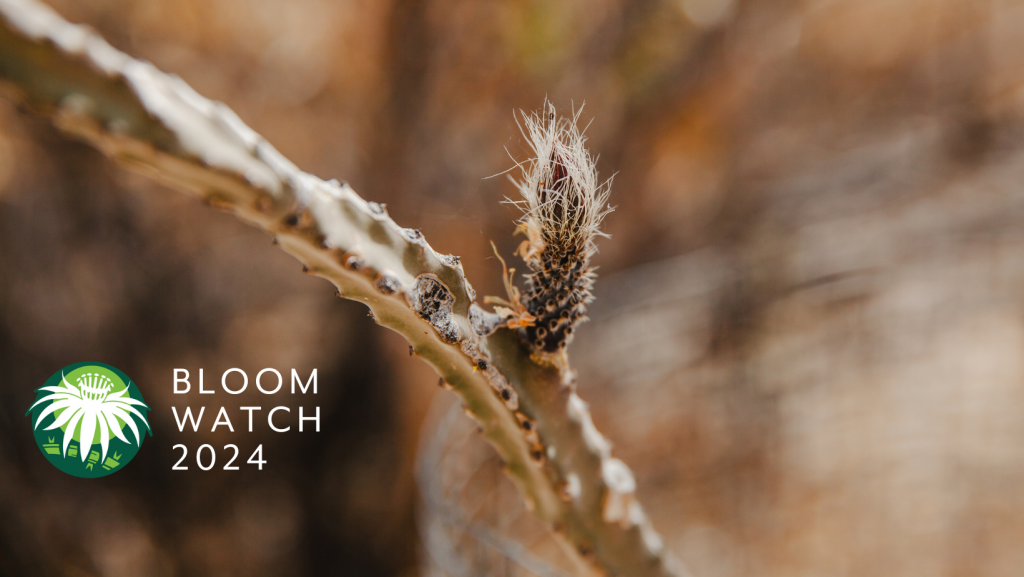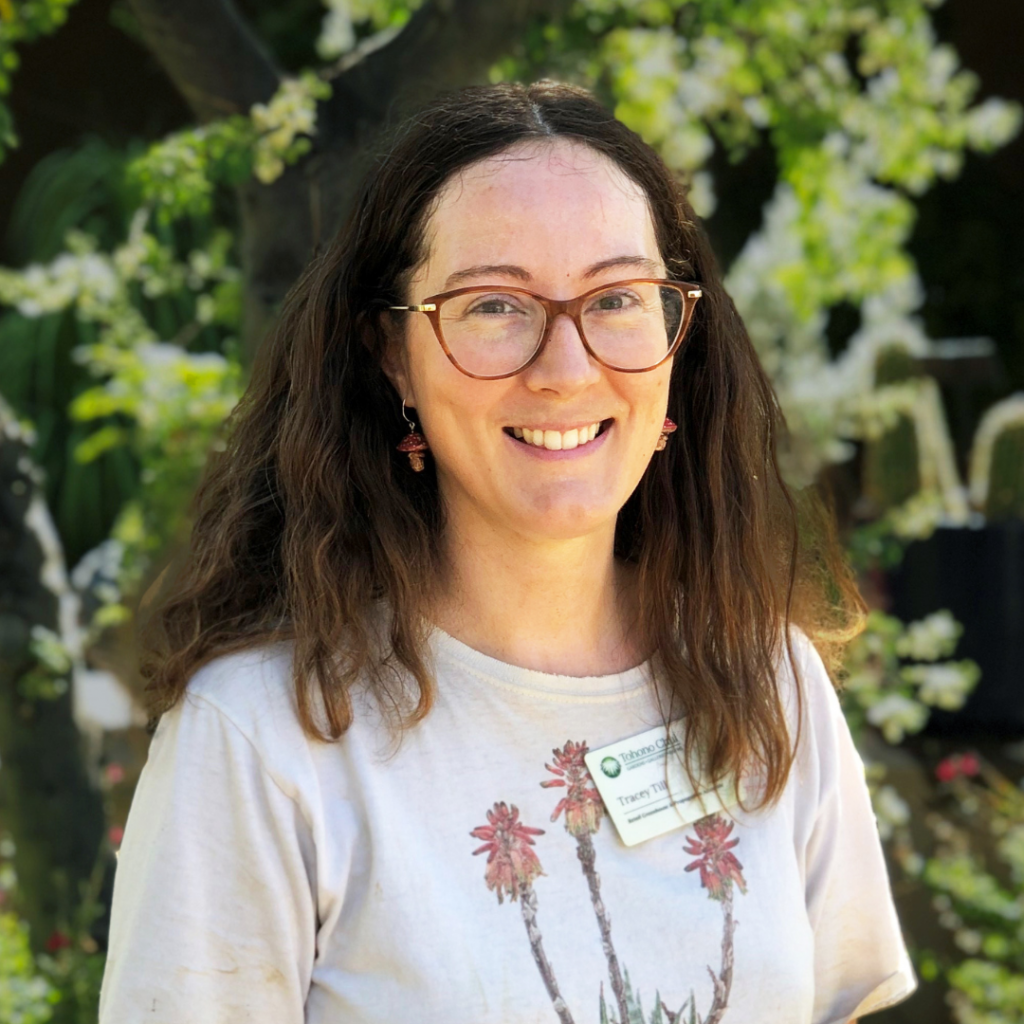
Bloom Watch #2 | Beneath the Surface
June 21, 2024Tohono Chul Gardeners Chris Kibler and Shauna Smith, along with dedicated volunteer Tammy, have been diligently watching over the Queens and measuring their progress.
Shauna and Chris recorded measurements of the growth of the buds for our records. “Most are at 40 mm, with a few near 60mm. With the onset of this heat they’ve slowed down.” said Chris, Senior Gardener at Tohono Chul. According to the Gardeners, Bloom Night could be anywhere between 2-4 weeks out. But as we all know, Mother Nature works on her own timeline.

I ventured out to the Desert View Trail early Tuesday morning to see the Queens for myself and hear what the trail has to say…
Larrea sparkle in the morning sun, as if covered in dew. Seeds waiting for the winds of change, the monsoon.
A gossamer seed released like a puff of smoke, floats by.
Spiderwebs glisten between branches, the invisible is visible.
Every tree is a tree house for the beetles and bees. You can see the small oval holes like windows.
A wasp, brown and red, hovers over a Queen of the Night.
Flowerbuds! They decorate the plant like little black and white flames. Star-shaped spines cling to the trunk of their nursery tree, an acacia.
Amongst the wild trees and grass the soil is covered in white and orange stones.
Gneiss stones freckled with garnets slowly worn away into sand by streams of rainwater and wind.
Many small footprints appear in the dusty, well-worn path. Hoof, paw, and claw. An occasional sneaker print from a Tucsonan.
My walk makes me wonder, what is this gravelly soil made of anyway? Why does the Peniocereus greggii grow here and not everywhere?
Heading back to civilization and leaving the peaceful morning vista, I’m sitting at my desk. I decided to let my curiosity stray from the winding paths of the Desert View Trail and onto the winding paths of a Google search. I came upon the Web Soil Survey website (provided by the USDA) and looked up the Desert View Trail’s location on their interactive soil map. Now, soil science is a foreign language to me, so I must read slowly to understand… “Alluvium derived from schist and/or alluvium derived from gneiss… along with other granitic and some volcanic and sedimentary rock”.
Okay, let’s break this down!
Alluvium is made of sand, gravel, silt, and clay deposited by flowing water. According to their website, The Desert View Trail and much of the surrounding area were likely formed during the Ice Age when mountain glaciers melted and produced lakes and rivers that deposited these sediments. Over time, calcium carbonate was also formed as slightly acidic rainwater trickled through the layers. The expanse of time; the natural forces of water, wind, and sun that shaped the landscape is awe-inspiring!
It seems the Queen of the Night is well adapted to the sandy, silty, gravelly soil. Perhaps adequate moisture and drainage are all that is necessary to allow the large tuberous root to grow and to prevent rotting.
Earlier, botanist and Tohono Chul Gardens Manager, Jack Dash, brought up the question to me of whether the baby Queens we are growing in the nursery could benefit from symbiotic microbes native to the desert soil.
Perhaps more is going on than can be easily seen. What else could be going on beneath the surface? Soil is not only a collection of tiny non-living rocks but a thriving and bustling community and ecosystem. It’s filled with active plant roots, algae, fungus, bacteria, and small invertebrates.

Many people know about the miraculous mycorrhizal (fungi that have a symbiotic relationship with the roots of many plants) that colonize tree roots and enable them to absorb more nutrients from the soil. It turns out that cactus also facilitate partnerships with fungi friends! According to the book Cactus Biology and Uses, root samples of different Sonoran cactus species were anywhere from 10% to 70% colonized by mycorrhizal fungi.
However, I have yet to dig up an article specific to Peniocereus greggii mycorrhizae. What might be happening beneath the soil of our Queens? For now, it remains a mystery to me.
The Queen knows where to grow. The Queen knows when to bloom. When she is ready.
We are estimating about 2 to 4 weeks away from the big night!
Stay tuned for updates.
Click here to sign up for Bloom Watch emails.
Be sure to select “Bloom Watch” on the dropdown menu.
Members Only
This year, Bloom Night is an exclusive members-only event. Your support helps preserve the Desert View Trail and our Peniocereus greggii collection while we work to ensure proper pollination of these special plants.
Don’t miss out—become a member today and unlock a year of perks and benefits at Tohono Chul, including early access to plant sales, discounts, free daily admission, reciprocal admissions at other public gardens, and much more.
Predictions and estimates for Bloom Night are subject to change based on various factors such as weather conditions, growth patterns, and environmental influences.








